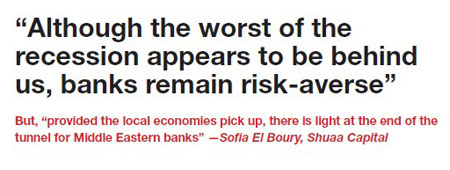EM REGIONAL BANKING FOCUS: MIDDLE EAST
By Jonathan Gregson
Many banks in the Middle East are still suffering the after-effects of the global financial crisis.

Over the past decade the Middle East’s banking sector has become one of the fastest-growing in the world. Previously it had been under-banked, and in many countries state-owned banks remained the dominant players. Some regional banks did well, but it was not high on the big league banks’ agenda. But with the opening up of key markets to newly licensed international banking groups, the development of shariah-compliant financial products and such funding instruments as sukuk bonds, and the meteoric rise of Dubai as a major financial center, the Middle East appeared to have become a banking bonanza. International headhunters offered mouthwatering packages to lure skilled personnel into the shiny new financial towers rising out of the desert.
The first wave of the global credit crisis did nothing to dent the region’s confidence and ambition. Middle Eastern banks had virtually no exposure to US subprime or associated securitizations and derivatives. And with energy prices climbing to record highs during the summer of 2008, the economies of the region’s resource-rich countries continued to expand. IMF figures for the whole of Middle East and North Africa put average GDP growth at 5.3%, though the Gulf hot spots far exceeded this. Much of the surplus oil revenue was channeled into government-led infrastructure projects, usually with local bank participation, while excessive liquidity among private sector banks was mainly directed into real estate construction and consumer loans.
Cracks did appear, though. Competition in such over-banked countries as the United Arab Emirates (UAE)—where there are 52 banks (split evenly between local and foreign-owned) for a population of just 4 million—became intense, the consequences being either eroded margins, excessive risk-taking or a combination of the two. “Banks had overstretched themselves during the run-up to the point when the real estate bubble burst,” says Domluke Da Silva, the Dubai-based chief operating officer of Arabia-Asia Capital Alliance. Their real estate and consumer lending ballooned in the low-interest environment of the early 2000s, with loan growth in the UAE reaching 24% during early 2008. More worrying is the fact that some banks became over-dependent on wholesale funding. The resulting mismatch between lending to long-term borrowers and funding through short-term bonds and inter-bank lending put serious strains on both liquidity and balance sheets. The sharp downturn in real estate values triggered a wave of nonperforming loans and pushed some smaller banks close to insolvency.
Governments and central banks intervened. “In Qatar the authorities decided up front to remove some of the risks from banks’ balance sheets, purchasing nearly $2 billion worth of local equity portfolios and $4.1 billion of real estate assets held by the country’s nine local banks,” says Sofia El Boury, banking analyst at UAE-based investment bank Shuaa Capital. The UAE’s central bank responded with a blanket guarantee of local banks’ deposits and an emergency inter-bank facility to alleviate short-term liquidity needs, while Abu Dhabi pumped in billions of Tier 1 capital into its five local banks and then parted with even more billions to shore up its neighboring emirate Dubai when majority state-owned Dubai World and associated companies unilaterally ceased paying interest on $25 billion of debt.
A full-blown crisis in Dubai, which for a time threatened to be a re-run of the Lehman Brothers collapse, was eventually averted and practically all creditors have now accepted the proposed restructuring and amended terms. “Hard lessons have hopefully been learned,” says Da Silva, “and there is a lot more focus on risk management and higher-quality lending practices.” However, some observers are concerned that another potential problem most banks have apparently yet to tackle adequately is the retail credit explosion, in terms of credit card debt and personal loans. At the retail level banks have been very aggressive in pushing these products on people without proper credit screening, they believe.
Banks Rebuild Foundations
“Banks have continued their balance sheet repair,” says Da Silva, though it will be a gradual process. It helps, he suggests, that “client deposits have been increasing as investors in the region continue to be averse to anything riskier than a cash deposit.” However, with banks competing for such business by offering customers higher interest rates, he believes they still face margin erosion from escalating funding costs.
While the global downturn has hit banks right across the Middle East, there are stark differences between its very different sub-regions. Even among the Gulf Cooperation Council (GCC) countries, whereas the UAE is looking at no growth this year, gas-rich Qatar’s economy continues to grow, and bank lending expanded by roughly 10% in the year to July, according to El Boury.
Saudi Arabia is buoyed up not only by its oil production but by its large and youthful population, a $375 billion government infrastructure program to be completed over five years and the planned building of new “economic cities.” That is not to say that its banks did not run into problems. The struggles of two large and heavily indebted private Saudi companies, Saad Group and Algosaibi, forced Saudi banks to nearly double their loan loss provisions last year, for example.

Egypt, with its more diversified economy and huge population, presents a very different story, as does Lebanon with its large diaspora and concentration of outward-looking banking expertise. However, the greatest opportunities are probably in Saudi Arabia, which with only 12 licensed banks remains an under-penetrated banking market, according to El Boury, with great scope for new products and opening more branches.
Da Silva sees the main drivers of banking in the GCC being the massive infrastructure build-out the countries have earmarked, and their efforts to diversify from hydrocarbon-based economies. Moreover, practically all governments in the region are now keen to engage in public-private partnerships.
Cross-border activity and M&A; activity has been muted recently—apart from when it has been necessary to step in and save smaller, overstretched banks—though that could soon change. “We are seeing some Middle Eastern banks looking to expand outside their bases, particularly into nearby countries,” observes Da Silva. However, in terms of growing their businesses, he believes that foreign-owned banks, with their lower-cost funding, might be better positioned to take advantage of demand for capital and funding for large infrastructure projects from both public and private sectors. In this they are well placed to outbid local banks, which face being priced out of the market and have already overstretched their loan books, Da Silva argues.
El Boury foresees only a slow recovery for lending and profitability. “Although the worst of the recession appears to be behind us, banks remain risk-averse and reluctant to extend credit to the private sector,” she observes. “Apart from the obvious risks in deteriorating asset quality, there is also the opportunity risk some banks will face in missing out on the recovery due to funding constraints,” she adds. On a more positive note, she believes banks in the region will continue to mend their funding gap by growing their deposit base, which will allow for a commensurate build-up in the loan book.
“Provided the local economies pick up, there is light at the end of the tunnel for Middle Eastern banks,” she asserts.



